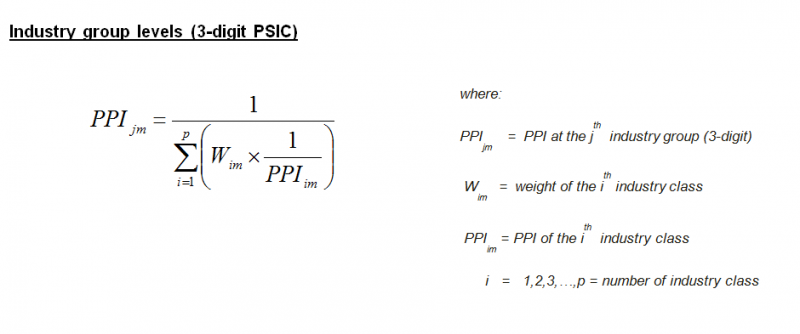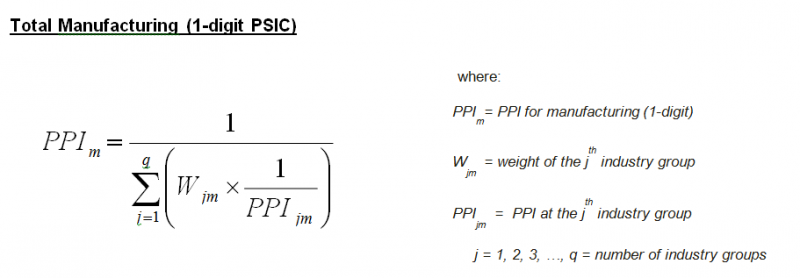Table A Year-on-Year and Month-on-Month Growth Rates of Producer Price Index: July 2015 and June 2015 | ||
|---|---|---|
TOTAL MANUFACTURING | July 2015 | June 2015 |
| Producer Price Index (2000=100) | 139.7 | 140.4 r |
| Year-on-Year Growth | -6.4 | -6.3 r |
| Month-on-Month Growth | -0.5 | 0.3 |
- Producer Price Index decelerates further in July 2015
Producer Price Index (PPI, 2000=100) for manufacturing went down by 6.4 percent in July 2015 compared with negative 1.5 percent in July 2014. The heavily weighted petroleum products and electrical machinery sectors, which decreased by 25.5 percent and 16.9 percent, respectively, led the sectors that pulled-down the year-on-year performance of the July 2015 PPI. Other sectors with double-digit decreases were the following: wood and wood products (-19.5%) and furniture and fixtures (-18.0%). On the other hand, the remaining ten sectors reflected single-digit increases led by beverages (9.8%). Refer to Tables 1 and A-1.
On a month-on-month performance, PPI likewise decreased by 0.5 percent from a positive growth of 0.3 percent during the previous month. This can be attributed to the rollback in the prices of gasoline, diesel, kerosene and LPG which resulted to the decline of the heavily weighted petroleum products sector by 4.5 percent. Furthermore, two sectors posted flat growths while twelve sectors reflected increases. Refer to Tables 1 and A-2.


Gainers | Year-on-Year Growth (percent) | |
|---|---|---|
| July 2015 | June 2015 (revised) | |
| Beverages | 9.8 | 8.9 |
| Machinery Except Electrical | 2.7 | 0.7 |
| Miscellaneous Manufactures | 6.6 | 1.4 |
| Chemical Products | 1.4 | 1.9 |
| Food Manufacturing | 0.3 | 0.0 |
| Fabricated Metal Products | 2.1 | -2.6 |
| Paper and Paper Products | 2.4 | 2.4 |
| Tobacco Products | 0.9 | 0.9 |
| Textiles | 1.2 | 1.1 |
| Leather Products | 0.7 | 0.5 |
Losers | Year-on-Year Growth (percent) | |
|---|---|---|
| July 2015 | June 2015 (revised) | |
| Petroleum Products | -25.5 | -19.7 |
| Electrical Machinery | -16.9 | -18.0 |
| Basic Metals | -8.5 | -6.1 |
| Transport Equipment | -2.0 | -2.5 |
| Non-Metallic Mineral Products | -5.9 | -6.5 |
| Wood and Wood Products | -19.5 | -20.9 |
| Rubber and Plastic Products | -3.0 | -0.5 |
| Printing | -1.6 | -1.7 |
| Footwear and Wearing Apparel | -0.1 | -1.3 |
| Furniture and fixtures | -18.0 | -14.7 |
Gainers | Month-on-Month Growth (percent) | |
|---|---|---|
| July 2015 | June 2015 (revised) | |
| Transport Equipment | 0.8 | -1.8 |
| Miscellaneous Manufactures | 3.4 | 1.0 |
| Machinery Except Electrical | 0.7 | -0.2 |
| Paper and Paper Products | 1.3 | -0.2 |
| Footwear and Wearing Apparel | 1.1 | -1.9 |
| Wood & Wood Products | 1.4 | 1.0 |
| Food Manufacturing | a/ | 0.3 |
| Fabricated Metal Products | 0.3 | 0.3 |
| Furniture and Fixtures | 0.9 | 1.9 |
| Textiles | 0.6 | 0.3 |
| Non-Metallic Mineral Products | 0.1 | 0.2 |
| Leather Products | 0.2 | 0.3 |
| Printing | 0.1 | 0.4 |
| Beverages | 0.0 | 0.0 |
| Tobacco | 0.0 | 0.0 |
Losers | Month-on-Month Growth (percent) | |
|---|---|---|
| July 2015 | June 2015 (revised) | |
| Petroleum Products | -4.5 | -0.4 |
| Electrical Machinery | -1.5 | 1.2 |
| Basic Metals | -2.4 | -0.7 |
| Rubber and Plastic Products | -2.7 | 0.3 |
- Introduction
- Method of Index Computation




- Industry Coverage
Starting with January 2013 reference month, the PPI utilizes the 2009 Philippine Standard Industry Classification (PSIC) to classify sectors and industries. Selected industry classes of the 2009 PSIC were grouped to form the 20 industry groupings of the 2014 PPS. These are presented in the table below.
2009 PSIC CODE | INDUSTRY DESCRIPTION |
|---|---|
| C10 | Food manufacturing * |
| C11 | Beverages |
| C12 | Tobacco products |
| C13 | Textiles* |
| C14,C152 | Footwear and wearing apparel |
| C151 | Leather products |
| C16 | Wood and wood products* |
| C17 | Paper and paper products |
| C18 | Printing and reproduction of recorded media |
| C19 | Petroleum products* |
| C20,C21 | Chemical products* |
| C22 | Rubber and plastic products* |
| C23 | Non-metallic mineral products* |
| C24 | Basic Metals* |
| C25 | Fabricated metal products |
| C262,C275,C28,C263,C268 | Machinery except electrical* |
| C261,C264,C27,C29301 | Electrical machinery* |
| C29 except C29301,C30 | Transport equipment |
| C31 | Furniture and fixtures |
| C265,C266,C267,C32 | Miscellaneous manufactures |
Note: * - Major sectors categorized into sub-sectors
- Response Rate
The response rate for July 2015 is 80.2 percent, which corresponds to the retrieval of 584 establishments’ reports out of the 728 samples for the survey. Refer to Table B.
Response rates for beverages, and rubber and plastic products reached 100 percent and 91.3 percent, respectively. Refer to Table 2.
Table B Response Rates For Total Manufacturing (In Percent) | |
|---|---|
July 2015 | June 2015 (revised) |
80.2 | 90.4r |
Missing prices for products of sample establishments are estimated using the short-term geometric mean of the actual prices of responding samples within the same industry class. Revisions to the preliminary estimates are done upon receipt of actual reports from late responding establishments.
